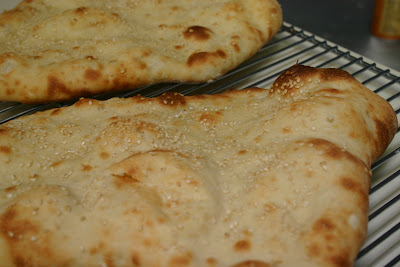Let me just say that I do not belive that there is such a thing as too many cookbooks. What a ridiculous concept. Oh, sure, I have watched hours of television programming about hoarders; I have seen those people pushed out of their bedrooms and homes by their own collections of stuff, whose lives have become dominated by mountains of clothes, styrofoam containers, and plastic figurines...insignificant things. But cookbooks? No way.
Not only are cookbooks the ultimate how-to manuals, but if you will allow me to be grand and only slightly overstated for a moment...cookbooks give us a way to recreate history. Wow - really, Tom? Yes! Okay, not all cookbooks do that. (I have one slim volume entitled The Classic Carrot Cookbook which may provide a counterargument to the whole history theory, but, if push came to shove, I'm sure that somebody could find some recipe on those orange-hued pages that elicits memories of picnics by the lake.)
Look through most any cookbook and you will see numerous references such as "a dessert I had on my first trip to Paris" or "my mother's never fail pie crust" or "the pot roast from countless Sunday dinners." Food is a multisensory reminder of times past. And not only when you eat it, but also when making it. Hold a heavy wooden rolling pin in your hand and generations of bakers are lined up behind you. The next time you make whipped cream, imagine how many times your mother or father, or grandmother, or greatgrandmother lifted the whisk to check the consistency of the cream before serving it on the pumpkin pie at Thanksgiving.
The French have a reputation for being all this-and-that about their cuisine, in part because they were the first culture to document their culinary techniques and traditions. Sure, the Bedouins may have been stewing goat heads for thousands of years before the first puff pasty was made, but they never wrote it down...they are a nomadic culture, so no doubt toting boxes of goat recipes was not a first priority on their limited camel space. With only recall to go on, little Mohammed can't be sure that the goat head he is eating in his tent is exactly like the goat head that his greatgrandfather stewed up. But when little Pierre climbs up on the kitchen stepstool to make his first Tarte Tatin, he can follow the directions exactly and be confindent that it will taste just like Grandmama's.
But I don't mean to minimize the oral tradition of the kitchen (or the tent). We can probably all remember some tidbit of food knowledge that we heard from our mothers (don't cut lettuce with a knife; chill the bowl and beaters before you whip the cream; an open can of kidney beans is the most dangerous food there is), but these are generally technique remarks rather than specific recipes. For recipes I turn to my trusty stack of index cards with Grandma's recipes on them (Sour Cream Coffee Cake, Baking Powder Biscuits, Rolled Molasses Cookies) or to one of my many treasured cookbooks.
 These Oatmeal Raisin Cookies are from "The Church Book." There are probably thousands of similar books on bookshelves across the nation...you know, collections of recipes published by the women's fellowships from every church in every town in every state, providing generations of the devout with cholesterol and pot luck dishes for all eternity. (Despite their reputation for covered dishes containing condensed soups, these books are not restricted to midwest Christians. I am the proud owner of the 1972 Edition of the Hadasah Cookbook from Rochester, New York.)
These Oatmeal Raisin Cookies are from "The Church Book." There are probably thousands of similar books on bookshelves across the nation...you know, collections of recipes published by the women's fellowships from every church in every town in every state, providing generations of the devout with cholesterol and pot luck dishes for all eternity. (Despite their reputation for covered dishes containing condensed soups, these books are not restricted to midwest Christians. I am the proud owner of the 1972 Edition of the Hadasah Cookbook from Rochester, New York.) "The Church" from which my well-used "Church Book" hails, is the First United Methodist Church of Longmont, Colorado. And amidst the questionable recipes on those pages are to be found some real keepers, often marked by my mother with a simple "good" in the margin.
My sister tells me that in her copy my mother also identified some of the clunkers...apparently I was left to find those myself, not difficult in some cases.
Though these are called "Grandmother's Oatmeal Cookies," they aren't from my Grandmother. But that doesn't matter because I've tweaked the recipe a little bit anyway, and that's not a sacrilege, that's how cuisine evolves. But with the cookbook in hand, we can always return to the orginal, to Grandma's way, when the newer version turn out like hockey pucks...or fossils (which these didn't - they are delicious).
Grandmother's Oatmeal Cookies
Yield: 30 cookies
Eggs, well beaten 3
Vanilla 1 tsp
Raisins 1 cup
Butter, room temp 8 oz
White Sugar 1 cup
Brown Sugar 1 cup
AP Flour 2 1/2 cups
Salt 3/4 tsp
Baking Soda 2 tsp
Cinnamon 1 tsp
Nutmeg 1/2 tsp
Oats 2 cups1. Preheat the oven to 350 degrees.
2. Combine the eggs, vanilla, raisins in a small bowl. Let sit for 1 hour.
3. Thoroughly cream the butter and sugars.
4. Stir together the flour, salt, soda, cinnamon, nutmeg and add to the creamed mixture.
5. Add the egg-raisin mixture and the oats and mix until completely combined - the dough will be stiff.
6. Place heaping rounded Tablespoons of dough onto baking sheet. Bake for 15-17 minutes (until lightly browned on top).















